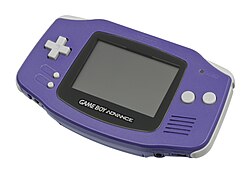Game Boy Advance
 The indigo version of the original Game Boy Advance | |
| Developer | Nintendo R&E |
|---|---|
| Manufacturer | Nintendo |
| Product family | Game Boy line |
| Type | Handheld game console |
| Generation | Sixth generation |
| Release date | Game Boy Advance:
AGS-001:
|
| Lifespan | 2001–2008[4] |
| Discontinued |
|
| Units sold | 81.51 million (as of June 30, 2010[update])[4] |
| Media | ROM cartridge |
| CPU | ARM7TDMI @ 16.78 MHz, Zilog Z80 @ 8 or 4 MHz |
| Memory | 32 KB internal, 256 KB external, 96 KB VRAM |
| Display | TFT LCD, 240×160 pixels, 40.8×61.2 mm[6] |
| Power | 2 × AA batteries |
| Best-selling game | Pokémon Ruby and Sapphire, 16 million combined[7] |
| Backward compatibility | Game Boy, Game Boy Color (GBA and GBA SP only) |
| Predecessor | Game Boy Color (1998)[8] |
| Successor | Nintendo DS (2004) |
The Game Boy Advance, commonly abbreviated as GBA, is a 32-bit handheld video game console. It was manufactured by Nintendo. The predecessor to the Game Boy Advance was the Game Boy Color. The Game Boy Advance was eventually succeeded by the Nintendo DS in 2004.
The Game Boy Advance was released in Japan on March 21, 2001. Nintendo later released it in North America on June 11, 2001, in Australia on June 20, 2001, and in Europe on June 22, 2001.
Other models[change | change source]
Game Boy Advance SP[change | change source]
The Game Boy Advance SP (announced in 2002) is one of the two Game Boy Advance variations, first released in Japan on February 14, 2003, in Europe on March 23, 2003,[9] in North America on March 28, 2003, and in Australia on April 10, 2003. It is similar to the original model, but it has a "clamshell" design, meaning that it can be folded to open and close which was later used in all the DS and 3DS models except the original 2DS. The Game Boy Advance SP has a rechargeable battery, and it does not run on two AA batteries. The Game Boy Advance SP has a backlit screen, meaning it has a bright screen (older versions of the GBA SP have a frontlit screen). Like its predecessor, it is backwards compatible with GB and GBC games.
Game Boy Micro[change | change source]
The Game Boy Micro is one of the two variations of the Game Boy Advance and is the last model in the Game Boy Line (alongside the AGS-101 model of the SP) announced at E3 2005. Development of the Micro began in 2004. It is smaller than most handhelds and is designed to fit inside coin pockets. It retains a rechargeable battery and backlit screen from the Game Boy Advance SP. The Game Boy Micro removed backwards compatibility with original Game Boy and Game Boy Color games as it is not compatible with accessories made for the GBA and SP. It also is incompatible with the Nintendo e-Reader. The Game Boy Micro also has a removable face plate for alternative designs. The Micro did not sell well as it was overshadowed by its successor, the Nintendo DS, which also plays GBA games.
- Size: 50×101×17.2 mm (2×4×0.7 in)
- Weight: 80 g (2.8 oz)
- Processor: 32-bit 16.8 MHz ARM processor (ARM7TDMI)
- Colors: various
- Screen: 51 mm / 2 inches, backlit with adjustable brightness.
- Resolution: 240×160 pixels
- Battery: built-in rechargeable lithium-ion battery. It has up to five hours of battery life with top brightness and sound and eight hours with both features on default.
- Headphones: standard 3.5mm headphone jack[10]
The Game Boy Micro has a switch on its right side to make the volume lower or higher. If the player presses the L shoulder button, it can be used to adjust the backlit screen between 5 different brightness levels.
Gallery[change | change source]
-
A Game Boy Advance SP
-
A Game Boy Micro
-
The Game Boy Micro is the size of a Nintendo Entertainment System controller. The control pad is similar to the Nintendo DS Lite system.
References[change | change source]
- ↑ "Game Boy Advance: It's Finally Unveiled". IGN. August 23, 2000. Retrieved July 19, 2014.
- ↑ Fielder, Lauren (May 16, 2001). "E3 2001: Nintendo unleashes GameCube software, a new Miyamoto game, and more". GameSpot. Retrieved July 19, 2014.
- ↑ Bramwell, Tom (March 21, 2001). "GBA Day: June 22nd". Eurogamer. Retrieved July 19, 2014.
- ↑ 4.0 4.1 "Consolidated Sales Transition by Region" (PDF). Nintendo. Archived from the original (PDF) on May 1, 2016. Retrieved November 18, 2016.
- ↑ 7 Things Everyone Should Know About the Game Boy Advance
- ↑ "Technical data". Nintendo of Europe GmbH.
- ↑ Rose, Mike (October 15, 2013). "Pokemon X & Y sell 4M copies in first weekend". Gamasutra. Think Services. Retrieved July 19, 2014.
- ↑ Umezu; Sugino; Konno. "Nintendo 3DS (Volume 3 – Nintendo 3DS Hardware Concept)". Iwata Asks (Interview: Transcript). Interviewed by Satoru Iwata. Nintendo. Retrieved March 7, 2011.
- ↑ Game Boy Advance SP on IGN
- ↑ [1][permanent dead link]". cNetUK. Retrieved on 08-20-09.



